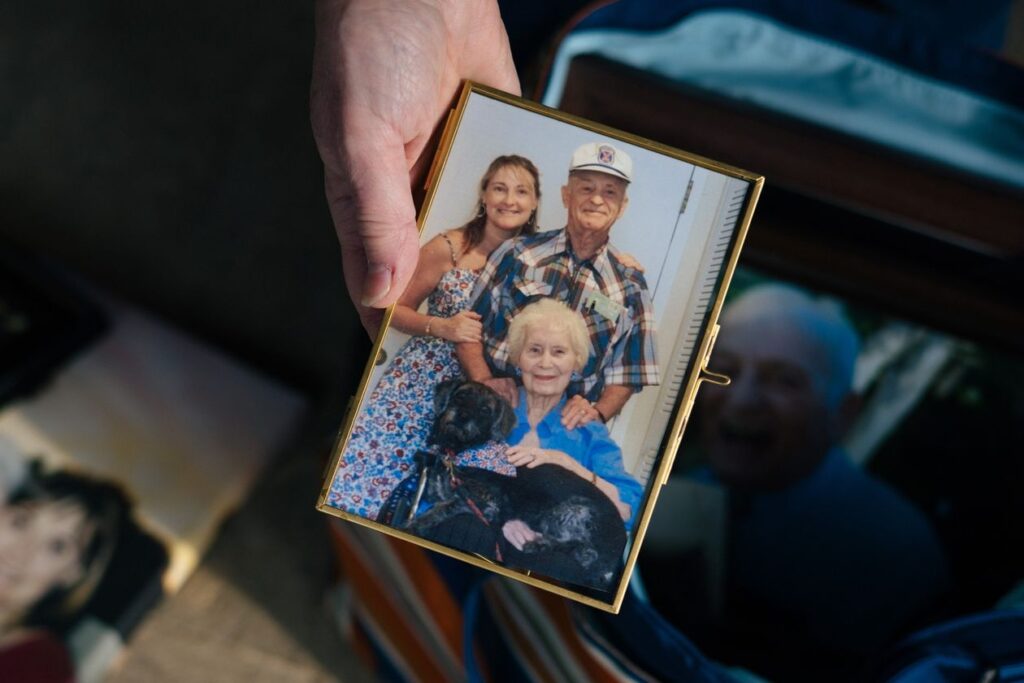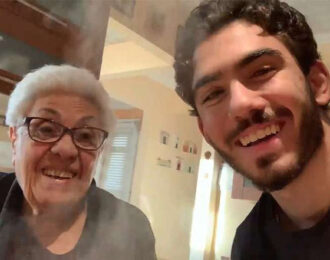Caring for Older Relatives Is So Expensive That Even AARP’s Expert Filed for Bankruptcy

By Clare Ansberry | Photographs by Alyssa Schukar for The Wall Street JournalFeb. 20, 2022 8:00 am ET
Amy Goyer is AARP’s family and caregiving expert. She has written two books on the subject and has her own consulting business.
“I am a caregiving expert. How did I end up in bankruptcy?” she says.
Ms. Goyer depleted her savings and ended up relying on credit cards after being financially drained by costs related to caring for her parents. After more than a decade of caring for her mom, who had a stroke, and her dad, who had Alzheimer’s, Ms. Goyer filed for bankruptcy protection in 2019.

She describes the bankruptcy experience as humiliating and embarrassing. But she says it shows how the unexpected costs of daily caregiving can accumulate over time and overwhelm even the most experienced of the nation’s 53 million family caregivers.
Family caregivers are the backbone of the nation’s long-term care system and provide an estimated $470 billion worth of free care—often at great personal cost. On average, caregivers spend 26% of their personal income on caregiving expenses, according to a 2021 AARP study, with most personal spending going to housing, including home modifications. A third of caregivers dip into their personal savings, like bank accounts, to cover costs, and 12% take out a loan or borrow from family or friends.
“I don’t think people understand how expensive caregiving is,” says Jean Chatzky, founder of HerMoney.com, a digital media company focused on women and personal finance.
Ms. Chatzky and others say family members incorrectly assume Medicare will pay for long-term care in nursing homes or in-home help, only to be surprised when a relative falls ill or needs that kind of care. Private long-term-care insurance picks up some of those costs, but the amount varies depending on the plan.
Caregiving is becoming more expensive because people are living longer with more complicated medical needs and hiring help costs more. The median annual cost of in-home care rose to $54,912 in 2020, an 18.5% increase from 2016, according to Genworth, a long-term-care insurance company.
The financial strain is widespread. Although the average caregiver is 49, about 23% percent are millennials, who have had less time in the workforce to build financial security. Concerns about the toll on family caregivers led to a recently introduced bipartisan Credit for Caring Act that would provide a tax credit of up to $5,000 to eligible working caregivers.

Ms. Goyer began her caregiving from a distance. Her parents lived in Phoenix. She lived in Alexandria, Va., and worked in Washington for the AARP. While her sisters pitched in, Ms. Goyer, who was single, childless and had a background in aging, managed their care and ultimately financed a large part of it.
At first, she would fly to Arizona several times a year, but began coming monthly as her parents’ health declined. Her mother, Patricia, who had a stroke at the age of 63, had frequent hospitalizations, and her dad’s cognitive abilities began slipping. In 2009, the doctor said that he had Alzheimer’s and that he should stop driving.
“That is when everything changed. I picked up my life and moved,” says Ms. Goyer.
Costs start to mount
She left her full-time position at AARP and started a consulting business, which gave her more flexibility to care for her parents but also meant added costs for things like health insurance.
She found a continuing-care community for her parents and moved into their house, taking over the mortgage and bills, while maintaining her Washington-area apartment to be close to her clients and boyfriend.
Her parents had long-term-care insurance, which along with Social Security and her dad’s pension, covered the monthly $4,000 fees at their independent living apartment. Personal-care services, including someone to help her mother bathe and dress, were extra. She paid for the extra care when it exceeded her parents’ budget.
When her parents needed 24-hour care, Ms. Goyer moved them back home, and took out a home-equity line of credit to install grab bars and a safe shower in the bathroom.
Ms. Goyer hired caregivers to watch her parents while she worked, but took over during evenings and weekends. One sister lived in Arizona and helped, but also had a child with special needs. Another sister flew from Ohio to cover when Ms. Goyer had to travel. Ms. Goyer personally paid for her flight.
As her parents’ savings dwindled and their needs increased, Ms. Goyer assumed more expenses, relying on credit cards to buy equipment, like special folding wheelchairs, and pay veterinary bills for Mr. Jackson, a service dog that had become her dad’s constant companion and source of comfort. The air-conditioning units died and had to be replaced. She paid with credit cards.
Her boyfriend, Bill Carter, who lived in Alexandria, came out and helped with small house projects. On occasion, she borrowed money from him to get through the month. “I know it was very hard for her to ask for that kind of help,” says Mr. Carter. “She was trying so hard to keep everything going.”
By 2013, she had $25,000 in credit-card debt. That year, her mother died. A year later, her oldest sister died. Ms. Goyer, her sister’s power of attorney, incurred additional expenses going to Maryland to help with her sister’s care.
Devastated by the losses, her dad, Robert, declined. She hired someone to help him exercise for his physical health and well-being. She tried alternative treatments, including acupuncture and Chinese medicinal herbs, which helped reduce his anxiety more than any other therapies and treatments.
“When you care for someone with dementia and love them so much, you get to the point that you do anything you can that works,” she says.
Overwhelmed by expenses
Her father’s medical and in-home care expenses reached $10,000 a month in the last two years of his life, exceeding his $8,000 monthly income from Social Security, pension, long-term care-insurance payments and Veterans Affairs benefits. Ms. Goyer, whose personal income from her consulting business ranged between $35,000 and $74,999 annually, picked up the $2,000 monthly shortfall, while also paying for the Phoenix house and her apartment in Alexandria.
In 2018, the year her dad died, her credit-card debt topped $120,000, with a large amount representing high interest rates on unpaid balances. She went to consumer-credit counselors and called credit-card companies trying unsuccessfully to get lower interest rates.
“I was just so overwhelmed financially, I couldn’t figure out how to dig out,” she says. She consulted lawyers and financial advisers, who recommended that she file for bankruptcy, which she did in 2019.
Mr. Carter, her boyfriend, says he felt relief. “I worried all the time about the tremendous strain Amy was under,” he says. “I felt that her debt had spiraled out of control that last year of her father’s life and bankruptcy was her only option.”
Bankruptcy was demoralizing. “I feel like even friends judge me,” says Ms. Goyer. She has no savings and must rebuild her credit rating. She is fortunate, she says, that she could continue working for the AARP and others, and plans to meet with a financial adviser, something she wishes she had done sooner.
She has no regrets about the care she gave to her parents or its cost.
“I made my choices and did my best for my parents,” she says. “If it can happen to me, it could happen to anyone.”





